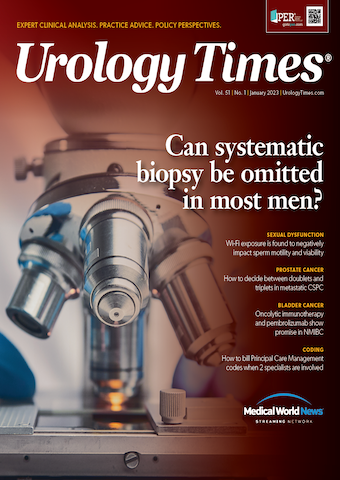Publication
Article
Urology Times Journal
Dr. Alicia Morgans details decision between doublets and triplets in mCSPC
Author(s):
“ADT intensification for patients with mCSPC is the standard of care; ADT alone is not enough," said Alicia Morgans, MD, MPH.

A critical component of the treatment paradigm in metastatic castration-sensitive prostate cancer (mCSPC) is deciding between doublet and triplet regimens, as the treatment standard has moved beyond androgen deprivation therapy (ADT)—alone or with docetaxel—for most patients, Alicia Morgans, MD, MPH, explained in a presentation at the 2022 LUGPA Annual Meeting.1
Morgans, who is the medical director of the Survivorship Program at Dana-Farber Cancer Institute and an associate professor at Harvard Medical School, said that the National Comprehensive Cancer Network guidelines have been updated, and it is recognized that ADT in combination with docetaxel is no longer recommended: “ADT alone is really not preferred here; it’s going to be a combination of a doublet or a triplet.”
Morgans further explained that the first factor to consider when selecting the optimal approach for each patient is whether they have high- or low-volume disease.
“For high-volume patients, I always think about if the patient is fit for chemotherapy. [If they are,] I can give them that triplet therapy of ADT, docetaxel, and an androgen receptor (AR)–targeting agent. If they are not fit, then we might just do ADT and an AR-signaling inhibitor,” Morgans said. “If the patient has low-volume disease, we usually err on the side of ADT and an AR-signaling inhibitor and we have to decide about radiating the prostate. This is the decision tree that I think through.”
Doublet Therapy
“The overall survival [OS] benefit [with a combination of ADT and an AR-targeted agent over ADT alone] was confirmed in multiple long-term analyses,” Morgans said.
Long-term data from the phase 3 LATITUDE trial (NCT01715285), which evaluated abiraterone acetate (Zytiga) plus prednisone and ADT (n = 597) vs ADT alone (n = 602) in patients with newly diagnosed, high-risk mCSPC, revealed a significant improvement in overall survival (OS) with the combination.2 The median OS in the abiraterone arm was 53.3 months (95% CI, 48.2–not reached) vs 36.5 months (95% CI, 33.5-40.0) in the placebo arm (HR, 0.66; 95% CI, 0.56-0.78; P < .0001).
The OS benefit of adding abiraterone and prednisolone to ADT (n = 501) over ADT alone (n = 502) in patients with metastatic hormone-sensitive disease was also demonstrated in the phase 3 STAMPEDE trial (NCT00268476) and confirmed with long-term data.3 The median OS favored the abiraterone combination (HR, 0.60; 95% CI, 0.50-0.71; P = .0000000003).
“We know that ADT and abiraterone is going to provide a better survival advantage vs ADT alone,” Morgans said. “We certainly saw this with our other agents, apalutamide [Erleada] and enzalutamide [Xtandi], [as well].”
Final data from the phase 3 TITAN trial (NCT02489318) showed that at a median follow-up of 44.0 months, apalutamide plus ADT (n = 525) resulted in a significant 35% reduction in the risk of death vs placebo plus ADT (n = 527).4 The median OS in the investigative and control arms was not reached (NR; 95% CI, NR-NR) vs 52.2 months (95% CI, 41.9-NR), respectively (HR, 0.65; 95% CI, 0.53-0.79; P < .0001).
The addition of enzalutamide to ADT was also found to prolong OS over placebo plus ADT in this population.5 Data from the phase 3 ARCHES trial (NCT02677896) showed that at a median follow-up of 44.6 months, enzalutamide/ADT (n = 574) reduced the risk of death by 34% vs placebo/ADT (n = 576; HR, 0.66; 95% CI, 0.53-0.81; P < .001). Moreover, updated data from the phase 3 ENZAMET trial (NCT02446405) showed that at a median follow-up of 68 months, the median OS with enzalutamide plus testosterone suppression (n = 563) was NR (95% CI, NR-NR) vs 73.2 months (95% CI, 64.7-NR) with a conventional nonsteroidal antiandrogen and testosterone suppression (n = 562; HR, 0.70; 95% CI, 0.58-0.84; P < .0001).6
Triplet Therapy
“So, what about triplet therapy? This is, importantly, going to be our combination that might be a little bit more toxic up front, but does seem to provide a bit of a bigger bang for our buck,” Morgans said.
When the Advanced Prostate Cancer Consensus Conference panel met in 2021, they were moving in the direction of ADT, docetaxel, and an AR pathway inhibitor for patients with high-volume disease, according to Morgans.
“Although [their vote] was split a bit, with providers at that time saying that ADT and an AR-targeting agent was really 1 of the preferred ways to go. Importantly, the vote happened after data from PEACE-1 [NCT01957436] came out, but before data from ARASENS [NCT02799602] came out. [I’m going to…] dig into these studies to familiarize everyone with why I think triplet therapy is something we should consider for a lot of our patients—especially if they have high-volume, de novo metastatic disease and fit for chemotherapy.”
PEACE-1
The phase 3 PEACE-1 trial had a 2x2 factorial design and enrolled patients with de novo mCSPC with distant metastatic disease. There was an on-study requirement of continuous ADT, and those who received ADT up to 3 months were allowed to participate.7,8 Study participants were randomly assigned 1:1:1:1 to receive standard of care (SOC) comprised of docetaxel and ADT (n = 296), SOC plus abiraterone (n = 292), SOC plus radiation (n = 293), or SOC plus radiation plus abiraterone (n = 292). Radiographic progression-free survival (rPFS) and OS served as the primary end points.
Data showed that the addition of abiraterone to ADT and docetaxel resulted in a significant improvement in median rPFS over SOC alone, at 4.46 years (interquartile range [IQR], 1.9-NR) vs 2.03 years (IQR, 1.09-NR), respectively (HR, 0.50; 95% CI, 0.34-0.71; P < .0001).
In the overall population, the groups who received SOC plus abiraterone also experienced improved OS over the groups who did not receive abiraterone, with a median OS of 5.7 years vs 4.7 years, respectively (HR, 0.82; 95.1% CI, 0.69-0.98; P = .030). Within the population of patients who received ADT plus docetaxel, the group that received SOC plus abiraterone had a median OS of NR vs 4.4 years in the groups that received SOC without abiraterone (HR, 0.75; 95.1% CI, 0.59-0.95; P = .017).
“Importantly, you can see these hazard ratios are really strong, demonstrating that survival benefit,” Morgans noted. “I do want to emphasize again, this is a de novo mHSPC patient population, so we think this is a more aggressive phenotype.”
ARASENS
“ARASENS really suggests a similar advantage to this type of approach with a triplet,” Morgans said.
The international phase 3 ARASENS trial enrolled patients with newly diagnosed metastatic disease who had an ECOG performance status of 0 or 1.9,10 “A majority of patients enrolled did have high-volume disease, from what we can figure out from the baseline characteristics [shared] although this was not determined prior to enrollment, at least in the data that have been released,” Morgans added. “A majority [also] appear to have de novo metastatic disease.”
Patients were randomly assigned 1:1 to receive ADT plus docetaxel for 6 cycles and darolutamide at 600 mg twice daily (n = 651) vs ADT plus docetaxel for 6 cycles plus placebo (n = 655). The primary end point of the trial was OS, and key secondary end points comprise time to metastatic castration-resistant disease, time to initiation of subsequent anticancer treatment, time to symptomatic skeletal-related (SSE) event-free survival, time to first SSE, and time to pain progression.
At a data cutoff date of October 25, 2021, the darolutamide regimen significantly reduced risk of death by 32.5% vs the control regimen. The median OS in the investigative arm was not evaluable (NE) vs 48.9 months (95% CI, 44.4-NE) in the control arm (HR, 0.68; 95% CI, 0.57-0.80; P < .001). Time to castration-resistant disease was longer in the darolutamide arm vs the placebo arm (HR for disease progression, 0.36; 95% CI, 0.30-0.42; P < .001). The darolutamide regimen also had prolonged time to pain progression vs the placebo regimen (HR for disease progression, 0.79; 95% CI, 0.66-0.95; P = .01).
“Here, again, we consistently see that differentiation and benefit of adding an AR-targeted agent onto an ADT/docetaxel backbone; there’s a clear and early separation of curves, demonstrating OS benefit [in the investigative arm],” Morgans said.
Take-Home Message
“ADT intensification for patients with mCSPC is the SOC; ADT alone is not enough. For treatment of patients with de novo, high-volume disease who are fit for docetaxel, I think this is the opportunity to use a triplet of ADT, docetaxel for 6 cycles, and either abiraterone, darolutamide, or enzalutamide as our partner, and we [should] continue that for maintenance. If a patient is unfit for docetaxel, they should receive ADT plus an AR-targeting agent,” Morgans concluded. “For patients with low-volume disease, there is not sufficient evidence to really push a docetaxel triplet, although we can offer it to really motivated patients. ADT and AR-targeted agent plus radiation to the prostate is really what I would recommend in that setting.”
References
- Morgans A. mCSPC: doublets vs triplets. Presented at: 2022 LUGPA Annual Meeting; November 10-12, 2022; Chicago, IL. Accessed November 11, 2022
- Fizazi K, Tran N, Fein L, et al. Abiraterone acetate plus prednisone in patients with newly diagnosed high-risk metastatic castration-sensitive prostate cancer (LATITUDE): final overall survival analysis of a randomised, double-blind, phase 3 trial. Lancet Oncol. 2019;20(5):686-700. doi:10.1016/S1470-2045(19)30082-8
- James N, Rush H, Clarke N, et al. Abiraterone acetate plus prednisolone for hormone-naïve prostate cancer (PCa): long-term results from metastatic (M1) patients in the STAMPEDE randomised trial (NCT00268476). Ann Oncol. 2020;31(suppl 4):S509. doi:10.1016/j.annonc.2020.08.871
- Chi KN, Chowdhury S, Bjartell A, et al. Apalutamide in patients with metastatic castration-sensitive prostate cancer: final survival analysis of the randomized, double-blind, phase III TITAN study. J Clin Oncol. 2021;39(20):2294-2303. doi:10.1200/JCO.20.03488
- Armstrong AJ, Azad AA, Iguchi T, et al. Improved survival with enzalutamide in patients with metastatic hormone-sensitive prostate cancer. J Clin Oncol. 2022;40(15):1616-1622. doi:10.1200/JCO.22.00193
- Updated overall survival outcomes in ENZAMET (ANZUP 1304), an international, cooperative group trial of enzalutamide in metastatic hormone-sensitive prostate cancer (mHSPC). J Clin Oncol. 2022;40(suppl 17):LBA5004. doi:10.1200/JCO.2022.40.17_suppl.LBA5004
- Fizazi K, Maldonado X, Foulon S, et al. A phase 3 trial with a 2x2 factorial design of abiraterone acetate plus prednisone and/or local radiotherapy in men with de novo metastatic castration-sensitive prostate cancer (mCSPC): first results of PEACE-1. J Clin Oncol. 2021;39(suppl 15):500. doi:10.1200/JCO.2021.39.15_suppl.5000
- Fizazi K, Galceran JC, Foulon S, et al. LBA5 a phase III trial with a 2x2 factorial design in men with de novo metastatic castration-sensitive prostate cancer: overall survival with abiraterone acetate plus prednisone in PEACE-1. Ann Oncol. 2021;32(suppl 5):S1299. doi:10.1016/j.annonc.2021.08.2099
- Smith MR, Hussain MHA, Saad F, et al. Overall survival with darolutamide versus placebo in combination with androgen-deprivation therapy and docetaxel for metastatic hormone sensitive prostate cancer in the phase 3 ARASENS trial. J Clin Oncol. 2022;40(suppl 6):13. doi:10.1200/JCO.2022.40.6_suppl.013
- Smith MR, Hussain M, Saad F, et al. Darolutamide and survival in metastatic, hormone-sensitive prostate cancer. N Engl J Med. 2022;386(12):1132-1142. doi:10.1056/NEJMoa2119115





























